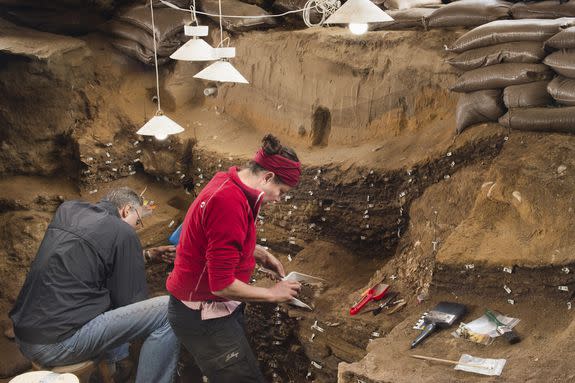The world's oldest human drawing is a hashtag-like doodle

Scientists have come across what they claim to be the earliest-known human drawing in South Africa.
The etching, reminiscent of a hashtag, was drawn with an ochre crayon on silcrete rock, and was discovered in Blombos Cave, which is located 300 kilometres (186 miles) west of Cape Town.
SEE ALSO: Please don't eat the world's oldest cheese
It's estimated to be 73,000 years old, predating previously known abstract and figurative drawings by humans from Africa, Europe and Southeast Asia by at least 30,000 years.
The results of the discovery were published in the journal Nature by researchers from Europe and South Africa, including Francesco d’Errico, Karen L. van Niekerk, Laure Dayet, Alain Queffelec, and Luca Pollarolo.
Christopher Henshilwood, a professor from Norway's University of Bergen who led the discovery team, explained to The Conversation that his team are "hesitant to call it 'art'."
"It is definitely an abstract design; it almost certainly had some meaning to the maker and probably formed a part of the common symbolic system understood by other people in this group. It’s also evidence of early humans’ ability to store information outside of the human brain," he said.

Image: Magnus Haaland
Henshilwood added that the cross-hatched patterns have been found on pieces of ochre in other sites, indicating our early ancestors' ability to reproduce graphic designs with different techniques.
"The discovery adds to our existing understanding of Homo sapiens in Africa. They were behaviourally modern: they behaved essentially like us. They were able to produce and use symbolic material culture to mediate their behaviour, just like we do now," he added.
"They also had syntactic language — essential for conveying symbolic meaning within and across groups of hunter gatherers who were present in southern Africa at that time."
Once used as shelter by hunter-gatherers, Blombos Cave is now a significant archaeological site for researchers seeking to understand our early ancestors.
Back in 2011, a painting kit made of abalone shells dating 100,000 years old was discovered in the cave, as well an an earlier discovery of ochre-painted shell beads.
WATCH: This artificial wave pool could change surfing forever


